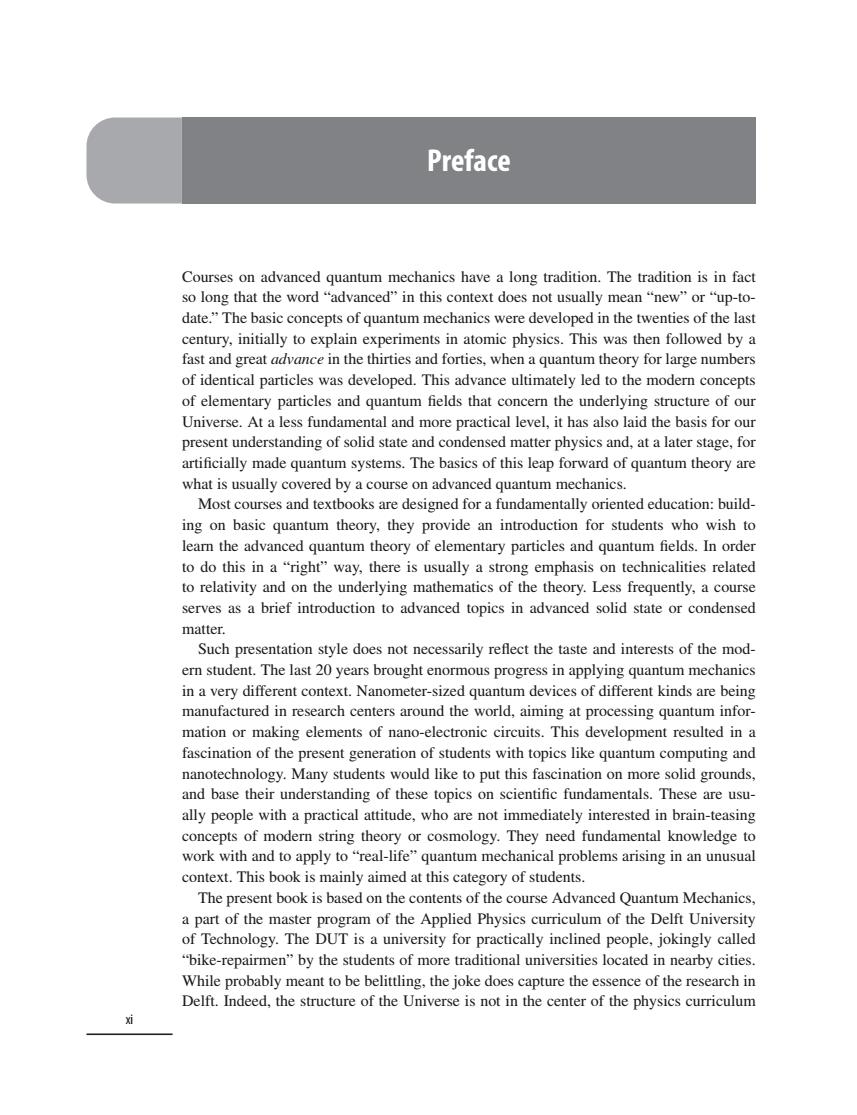正在加载图片...

Preface Courses on advanced quantum mechanics have a long tradition.The tradition is in fact so long that the word "advanced"in this context does not usually mean"new"or"up-to- date.The basic quantum mechanic were developed in the wenties of the ast century,initially to explain experiments in atomi fast and great advance in the thirties and forties,when a quantum theory for large numbers of identical particles was developed.This advance ultimately led to the modern concepts of elementary particles and quantum fields that concern the underlying structure of our Universe.At a less fundamental and more practical level,it has also laid the basis for our present understanding of solid state andc ndensed ma ter physics s and,at a later stage,for artificially made quantum systems.The basics of this leap forward of quantum theory are what is usually covered by a course on advanced quantum mechanics. Most courses and textbooks are designed for a fundamentally oriented education:build- ing on basic quantum theory.they provide an introduction for students who wish to h advanc ed quantum theor y of elementary particles and quantum fields.In order to do this in a"right"way.there is usually a strong emphasis on technicalities relate to relativity and on the underlying mathematics of the theory.Less frequently,a course serves as a brief introduction to advanced topics in advanced solid state or condensed matter. Such presentation style does not necessarily reflect the taste and interests of the mod- ern studen The last 20 years brought enormous progress in applying qu tum mechanics in a very different context.Nanometer-sized quantum devices of different kinds are being manufactured in research centers around the world.aiming at processing quantum infor mation or making elements of nano-electronic circuits.This development resulted in a fascination of the present generation of students with topics like quantum computing and technology. Ma ny ould like to put this fa inatio on olid and base their understan ling of t ese topics on scientific fundamentals grounds. These are usu ally people with a practical attitude,who are not immediately interested in brain-teasing concepts of modern string theory or cosmology.They need fundamental knowledge to work with and to apply to"real-life"quantum mechanical problems arising in an unusual context.This book is mainly aimed at this category of students. The present book is based on the contents of the course Advanced Quantum Mechanics a part of the master program of the Applied Physics curriculum of the Delft University of Technology.The DUT is a university for practically inclined people,jokingly called "bike-repairmen"by the students of more traditional universities located in nearby cities. While probably meant to be belitling.the joke does capture the essence of the research in Delft.Indeed,the structure of the Unive center of the physics Preface Courses on advanced quantum mechanics have a long tradition. The tradition is in fact so long that the word “advanced” in this context does not usually mean “new” or “up-todate.” The basic concepts of quantum mechanics were developed in the twenties of the last century, initially to explain experiments in atomic physics. This was then followed by a fast and great advance in the thirties and forties, when a quantum theory for large numbers of identical particles was developed. This advance ultimately led to the modern concepts of elementary particles and quantum fields that concern the underlying structure of our Universe. At a less fundamental and more practical level, it has also laid the basis for our present understanding of solid state and condensed matter physics and, at a later stage, for artificially made quantum systems. The basics of this leap forward of quantum theory are what is usually covered by a course on advanced quantum mechanics. Most courses and textbooks are designed for a fundamentally oriented education: building on basic quantum theory, they provide an introduction for students who wish to learn the advanced quantum theory of elementary particles and quantum fields. In order to do this in a “right” way, there is usually a strong emphasis on technicalities related to relativity and on the underlying mathematics of the theory. Less frequently, a course serves as a brief introduction to advanced topics in advanced solid state or condensed matter. Such presentation style does not necessarily reflect the taste and interests of the modern student. The last 20 years brought enormous progress in applying quantum mechanics in a very different context. Nanometer-sized quantum devices of different kinds are being manufactured in research centers around the world, aiming at processing quantum information or making elements of nano-electronic circuits. This development resulted in a fascination of the present generation of students with topics like quantum computing and nanotechnology. Many students would like to put this fascination on more solid grounds, and base their understanding of these topics on scientific fundamentals. These are usually people with a practical attitude, who are not immediately interested in brain-teasing concepts of modern string theory or cosmology. They need fundamental knowledge to work with and to apply to “real-life” quantum mechanical problems arising in an unusual context. This book is mainly aimed at this category of students. The present book is based on the contents of the course Advanced Quantum Mechanics, a part of the master program of the Applied Physics curriculum of the Delft University of Technology. The DUT is a university for practically inclined people, jokingly called “bike-repairmen” by the students of more traditional universities located in nearby cities. While probably meant to be belittling, the joke does capture the essence of the research in Delft. Indeed, the structure of the Universe is not in the center of the physics curriculum xi